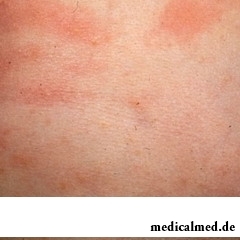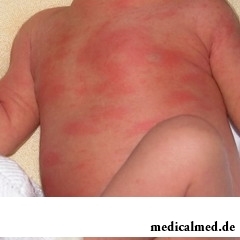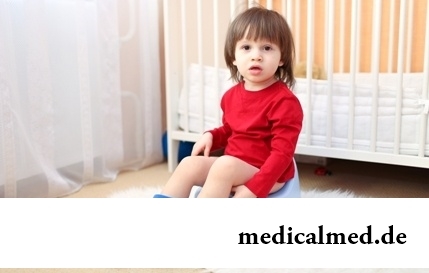





Toxic erythema
The toxic erythema represents polymorphic rashes on integuments of newborns in the first weeks of life. Rashes,  generally reflect process of adaptation of the baby to external vital conditions and the environment, after his stay in mother's womb. This borderline case passes within several days and arises at 20% of newborn children.
generally reflect process of adaptation of the baby to external vital conditions and the environment, after his stay in mother's womb. This borderline case passes within several days and arises at 20% of newborn children.
Reasons and symptoms of a toxic erythema
The toxic erythema of newborns is allergic reaction to components of breast milk and is subdivided into two stages – chemical and physiological. At the first stage there is a release of active agents which are mediators of allergic reaction. At the second stage of an erythema immunological changes which can be connected with problems of functioning of intestines, overcooling, bacterial damages are shown.
The clinical picture of a toxic erythema is characterized by emergence for the second or third day of life of allergic rashes on a face of the baby which are shown in the form of dense spots of gray-red color with small bubbles. Spots appear, generally on a face, the head, around joints, on buttocks and a breast. Allergic reaction can carry both local, and general character.
In certain cases within 3-4 days repeated rashes are observed, but more often allergic reaction takes place completely and is not shown again.
The toxic erythema of newborns causes concern, temperature increase, small consolidation of lymph nodes, dyspepsia and increase in the sizes of a spleen. In most cases, except external rashes, this allergic reaction affects physical and psychological state of the baby.
The disease is most often shown at babies who receive natural breastfeeding and only at 10% of babies who receive artificial feeding.
Diagnosis of a toxic erythema of newborns
The toxic erythema is established by a clinical method and microscopic analyses.
For definition of the exact diagnosis in nonspecific or disputable cases appoint blood test and a research of a corneous layer of epidermis. The research shows existence or absence in channels of sebaceous glands of papules of an erythema with hypostases and accumulation of infiltrate of leukocytes.
In certain cases appoint a research of structure of breast milk and identification in it individual allergens for the newborn.
Treatment of a toxic erythema
In overwhelming  number of cases the toxic erythema does not demand special treatment and passes within several days after the birth. In other cases appoint drug and physiotherapeutic treatment.
number of cases the toxic erythema does not demand special treatment and passes within several days after the birth. In other cases appoint drug and physiotherapeutic treatment.
The main treatment of a toxic erythema is begun with air bathtubs and special care of pustules on skin. The child should be protected from an adverse effect on skin, and also to exclude availability of allergens in mother's diet.
At long manifestation of allergic reaction appoint reception of antihistaminic drugs and biological means with the content of vitamins E, B6 and C, Rutinum and a laktobakterin.
If severe rashes around an umbilical cord are observed, then the doctor appoints 2 times a day to grease pustular elements with spirit solution, brilliant green and solution of 5% of potassium, and also to powder integuments with talc with a zinc oxide.
For normalization of the general condition of the baby at a toxic erythema recommend plentiful drink, fresh air, the use of solution of glucose and drugs with the content of potassium.
The most high temperature of a body was recorded at Uilli Jones (USA) who came to hospital with a temperature of 46,5 °C.

Herpes simplex of the first type (the infectious disease which is shown periodic bubble rashes on is called...
Section: Articles about health
Deciding to get rid of an addiction, not all imagine what effects it is necessary to face. Process of refusal of smoking causes quite essential discomfort in most of people: differences of mood, sleep disorder, fatigue, decrease физич...
Section: Articles about health
Wood louse – the ordinary-looking unpretentious plant extended in all territory of our country. It quickly expands, and sometimes fills sites, bringing a lot of chagrin to gardeners. Perhaps, they would be upset less if knew that the wood louse is valuable medicinal raw materials. A, C and E vitamins, organic acids, tannins, wax, saponins, lipids, mineral salts and essential oils are its part....
Section: Articles about health
No, probably, the person who would not have cold. Cold, cough, a headache – these symptoms are known to everyone. Peak to Prost...
Section: Articles about health
Some people consider what for medicine of the 21st century of secrets in the field of health of the person almost does not exist. It absolutely not so. The more answers scientists receive, the more the most difficult questions are raised for them by life. Besides, there are diseases, not объясн in any way...
Section: Articles about health
Water with a lemon - idle time in preparation drink which supporters of a healthy lifestyle already managed to appreciate. Used in a warm look and on an empty stomach, it is one of the most useful prophylactics allowing to prevent tens of diseases and just to raise an organism tone. Especially effectively to use warm water with lemon juice after a serious illness, during a season of the colds, and also to children, old men and pregnant women which do not have contraindications...
Section: Articles about health
The metabolism at each person proceeds in own way. However dependence between the speed of this process and disposal from superfluous in...
Section: Articles about health
The modern person not always manages to find housing in the environmentally friendly region and such work which would not do harm to health. With food stuffs at first sight the situation is much better: shops are overflowed with goods which are positioned пр...
Section: Articles about health
Popular joke that there are no healthy people, and is nedoobsledovanny, most of us considers an honest truth, continually it is necessary to hear that all of us are sick hardly from a school bench. It is hard to say whether so it actually because too often people are treated for nonexistent diseases, and sometimes call a disease what is something another. Sometimes in it the doctors of old school making diagnoses which are cancelled long ago – medicine still unless are guilty...
Section: Articles about health
"Epilepsy" doctors made the diagnosis in antique times. Displays of an illness and pattern of its development are very well studied. Odes...
Section: Articles about health
All got used long ago that, having addressed the plastic surgeon, it is possible to modify natural parameters of a figure or to minimize the damages put to appearance with ruthless time. Many people (preferential women) worldwide е...
Section: Articles about health
Eyes – unique body on the structure thanks to which the person obtains about 80% of information on the world around: about a form, color, size, the movement, and also many other parameters of objects or phenomena. But whether much we know about the most valuable sense body which, according to the scientist Sechenov, provides us about one thousand various feelings a minute? Let's consider 10 most surprising facts about eyes and sight....
Section: Articles about health
So, you resolved to lose weight. And now you try to understand what to begin with: from exercise stresses or a diet? And how to make, h...
Section: Slideshow
Such trouble as the milkwoman's attack, at least once in life happened almost to each woman. Prevalence of a disease is explained by the fact that the causative agent of an illness belongs to the so-called opportunistic microflora living on mucous an obol...
Section: Articles about health
Color of plants is caused by presence at them of certain chemical compounds. Let's talk about what is meant by various colors of vegetables and fruit and what properties they give them....
Section: Articles about health
Any person who faced a disease knows that treatment costs expensive. It belongs also to consultations qualified the specialist...
Section: Articles about health
Maternal milk is the best food for the newborn. It is the unique natural product containing an optimum set of nutrients, and which is best adapted in order that the baby normally developed and it was protected from harmful fa...
Section: Articles about health
Practically each person is familiar with the annoying, pulling, unscrewing pains caused by overcooling of muscles of a back. In certain cases inflammatory process is not limited to discomfort, being followed by emergence of hypostasis, consolidations, temperature increase. At the wrong treatment the acute miositis can lead to a chronic disease or aggravation of other pathologies of a back (vertebral hernia, osteochondrosis) therefore it is important to pay attention to symptoms of an illness in time and to start to...
Section: Articles about health
The main role in development of a peptic ulcer of a stomach and duodenum the bacterium Helikobakter plays pilor. Activity and Wuxi...
Section: Articles about health
Tick-borne encephalitis – one of the most dangerous viral diseases which causative agents transfer and is given to people by ixodic mites. These are the small blood-sicking insects living in the considerable territory of our country. The person bitten by a tick can catch...
Section: Articles about health
Is told about advantage of domestic animals for development of the child much. But many parents nevertheless do not hurry to bring pets as are afraid that they can do harm to health of children. What troubles can really trap kids and how to make joint life of a family and domestic animals comfortable and safe?...
Section: Articles about health
Heart disease and blood vessels lead to disturbance of blood supply of bodies and fabrics that involves failures in their works...
Section: Articles about health
All parents are ready to what the baby often and pisat much. Since then, as the absorbing diapers strongly became current, keeping of the kid in dryness does not represent any problems. But if the grown-up kid continues to urinate in panties, parents of a nacha...
Section: Articles about health
We live during an advertizing era. Daily each person receives a solid portion of persuasive councils about what to eat to be healthy and successful. Products about which we will talk today are combined by the following circumstance: all of them are positioned as the most useful and the most suitable for inclusion in a morning meal. Unfortunately, it is not true: these 10 products do not suit for breakfasts at all....
Section: Articles about health
Sometimes it seems that modern society was divided into two camps: representatives of the first are sure that has to for contraception отвеч...
Section: Articles about health
High temperature - a frequent symptom of such widespread diseases as a SARS, quinsy, pneumonia, etc. To reduce heat, having facilitated a condition of the patient, doctors recommend to accept antipyretics, however their use is not always possible. Too h...
Section: Articles about health
The brain of the person is studied not one hundred years, but the quantity of the riddles connected with this body increases rather, than decreases. Perhaps, numerous delusions concerning a structure and functioning of a brain are explained by it, many of which arose long ago, but continue to exist and today. Such we are ready to acquaint readers with the most widespread myths....
Section: Articles about health
